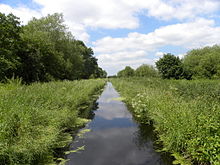| Site of Special Scientific Interest | |
 | |
| Location | Somerset |
|---|---|
| Grid reference | ST464394 |
| Coordinates | 51°09′05″N 2°46′04″W / 51.15134°N 2.76772°W |
| Interest | Biological |
| Area | 12.5 hectares (0.125 km2; 0.048 sq mi) |
| Notification | 1966 |
| Natural England website | |
Street Heath (grid reference ST464394) is a 12.5 hectare (31.0 acre) biological Site of Special Scientific Interest 4 km west of Glastonbury in Somerset, notified in 1966.[1][2] It next to the Glastonbury Canal and Ham Wall nature reserve. Street Heath has itself been designated as a Local Nature Reserve.[3][4]
Street Heath is a nature reserve, managed by Somerset Wildlife Trust, which has outstanding examples of communities that were once common on the Somerset Levels. It possesses a vegetation consisting of wet and dry heath, species-rich bog and carr woodland, with transitions between all these habitats. Rare ferns present include marsh fern (Thelypteris palustris) and royal fern (Osmunda regalis). Old peat workings and rhynes have a wetland community which includes bulrush (Typha latifolia), yellow flag iris (pseudacorus), cyperus-like sedge (Carex pseudocyperus) and lesser bur-reed (Sparganium minimum). Insects recorded include 33 species of butterflies, 200 moths and 12 grasshoppers and crickets, with several notable rarities. Birds breeding in the carr woodland include the local willow tit[1]
References[edit]
- ^ a b "Street Heath citation" (PDF). Sites of Special Scientific Interest. Natural England. Retrieved 26 July 2013.
- ^ "Map of Street Heath". Sites of Special Scientific Interest. Natural England. Retrieved 26 July 2013.
- ^ "Street Heath". Local Nature Reserves. Natural England. Retrieved 26 July 2013.
- ^ "Map of Street Heath". Local Nature Reserves. Natural England. Retrieved 26 July 2013.

Well, that’s interesting to know that Psilotum nudum are known as whisk ferns. Psilotum nudum is the commoner species of the two. While the P. flaccidum is a rare species and is found in the tropical islands. Both the species are usually epiphytic in habit and grow upon tree ferns. These species may also be terrestrial and grow in humus or in the crevices of the rocks.
View the detailed Guide of Psilotum nudum: Detailed Study Of Psilotum Nudum (Whisk Fern), Classification, Anatomy, Reproduction